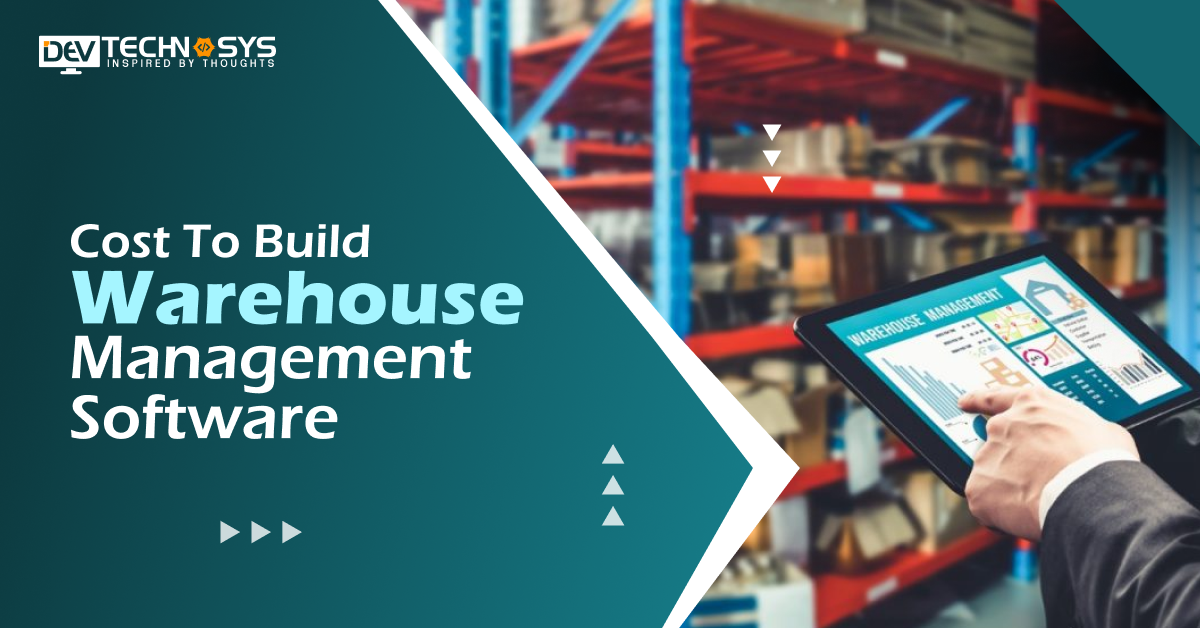Efficiently managing inventory in warehouses is a challenge that businesses of all sizes face. Without the right tools, inventory management can get hard and inaccurate, which can cause overstocking, stockouts, and inefficient operations.
That’s why many entrepreneurs like you are looking to invest in warehouse management software development. But before investing in this, you need to be aware of the cost to build warehouse management software. For budgeting and making smart choices, you need to know the WMS development cost.
Therefore, this blog will discuss the cost to build warehouse management software, crucial factors, key features and monetization strategies. Also, you will get to know about the tips to reduce the warehouse management software cost.
So, let’s begin!
What is Warehouse Management Software?
A warehouse management system is a software solution that helps you run your daily warehouse tasks. It helps businesses keep track of their inventory, customer orders, and deliveries to cut costs and work more efficiently.
Warehouse management software’s main job is to give accurate real-time information about inventory requirement, where it is, and when it needs to be reordered.
This system updates stock levels when an inventory shipment comes in or leaves the warehouse. This gives you real-time information about your inventory’s status. It also automates tedious tasks that used to be done by hand. It reduces mistakes and makes it easier to track inventory levels.
Future Predictions and Projections of the Logistics Industry
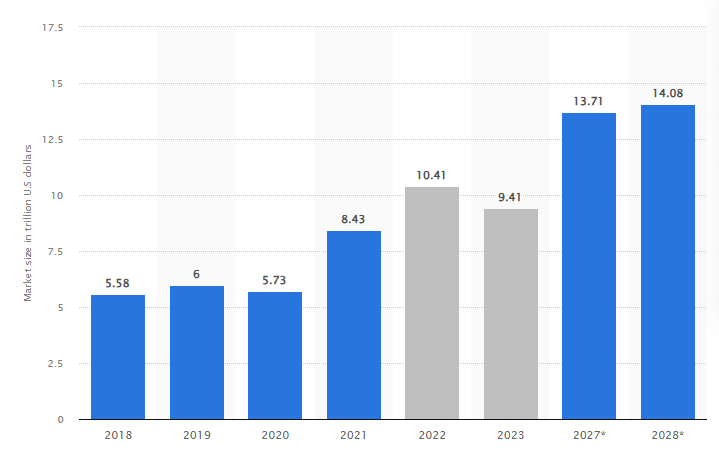
Source: Statista
- The global logistics industry recovered from the COVID-19 pandemic in 2023, with a market worth about $9.41 trillion USD. By 2028, it will be worth more than 14.08 trillion dollars.
- In 2024, with a 21 percent market share, OPEX was the biggest company in the world that made warehouse management software.
- Asia Pacific’s logistics management software market grew to over 3.9 trillion U.S. dollars that year.
- Due to the rise of online shopping, there will be just under 180,000 warehouses worldwide by 2025.
- The general warehouse segment has the most significant market share, about 70% of all the essential warehouse types.
- It is expected that by 2025, more than 50,000 warehouses will have 4 million commercial warehouse robots.
Types of Warehouse Management Systems
There are three main types of WMS software: standalone, cloud-based, and applications built into ERP or supply chain management platforms. Each type of WMS has advantages and drawbacks, and the best type will differ from business to business.
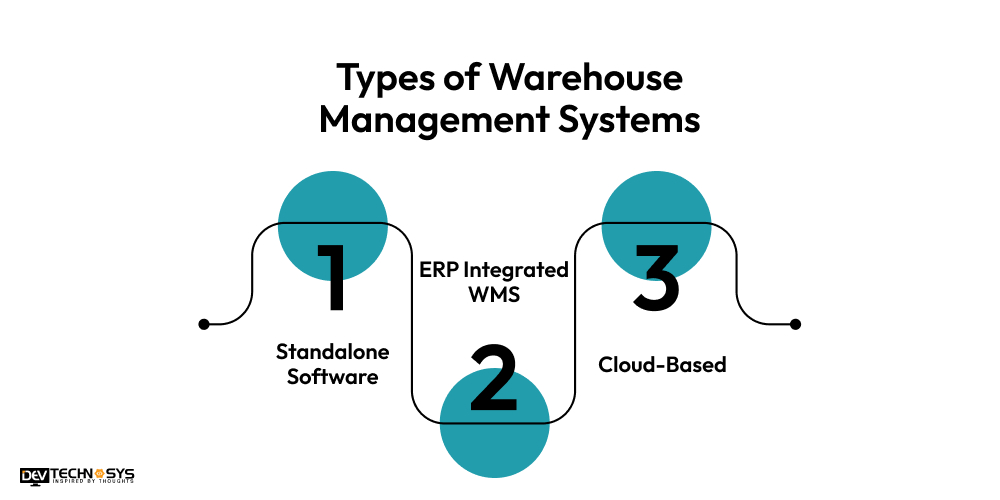
1. Standalone Software
One of the simplest types is stand-alone warehouse management software, which only has a few management features. The software is usually installed on-site and works with the company’s current hardware and network setup. Standalone WMS’s main features are managing inventory and running the warehouse.
2. ERP Integrated WMS
ERP-integrated warehouse management software is a robust solution combining many other systems’ features. It is considered one of the best software options, perfect for companies that want to improve their software and get ahead of the competition. You can develop an ERP System that work together smoothly and gives you complete features.
3. Cloud-Based
Cloud-based warehouse management software offers a web-based, centralized computing method using cloud technology. This type of WMS usually uses the SaaS model, known for being scalable, flexible, and easy to set up. Traditional WMS has the same benefits as cloud-based WMS, but adoption is faster, and supply chain WMS costs are lower.
Cost To Build Warehouse Management Software
The warehouse management software development cost can vary depending on your project requirements. A few factors like software complexity, features, design, technologies and so on affect the cost to build warehouse management software.
However, we can provide a rough estimate of warehouse management system development. It can range between $10,000-$30,000 or go beyond as per software complexity. For example, the cost will increase if you want to customize your software.
Let’s understand this from the below cost table.
| Software Complexity | Approx. Cost |
| Simple WMS software | $10000-$17000 |
| Medium WMS Software | $17000-$26000 |
| Medium WMS Software | $30000+ |
These are just the basic cost bifurcations. You can calculate the cost with the formula given below:
Total Warehouse Management Software Cost = Developer’s Hourly Rate * Development Time
Now that you know the warehouse inventory management software, consulting with a custom software development company is best. But first, you need to know the essential factors that affect the cost to build warehouse management software.
Factors Affecting the Warehouse Management Software Development Cost
Knowing the factors affecting the total cost is essential to understanding the cost to build warehouse management software. These factors determine the budget required to create a compelling and custom solution for managing inventory. Let’s have a quick look at those:
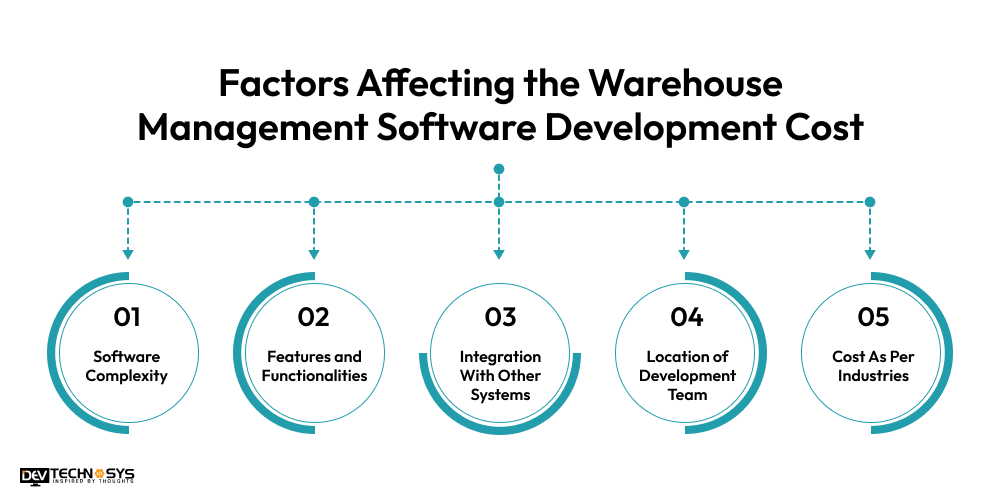
1. Software Complexity
The complexity of WMS software development cost go up or down. A simple system with essential features like tracking inventory and fulfilling orders will cost less. But a complex system with advanced features like tracking inventory in real-time, automating picking and packing, and connecting to other systems. However, making more complicated software takes longer and costs more.
| Software Complexity | Estimated Hours | Cost |
| Small (Basic) | 200 – 400 | $10000 – $15000 |
| Medium (Standard) | 400 – 800 | $15000 – $20000 |
| Large (Advanced) | 800 – 1200 | $20000 – $25000 |
| Enterprise (Complex) | 1200 – 2000 | $25000 – $30000 |
2. Features and Functionalities
The WMS software development cost is directly related to the number and complexity of features and functions. The AI inventory management software development with many features. For example, advanced analytics, reporting, and support for mobile devices, will take longer and cost more. However, it is easier and cheaper to make software with only the most basic functions.
| Number of Features | Estimated Development Hours | Cost per Hour |
| 1-5 (Basic) | 100 | $15-$25 |
| 6-10 (Standard) | 200 | $15-$25 |
| 11-20 (Advanced) | 400 | $15-$25 |
| 21-30 (Premium) | 600 | $15-$25 |
| 31+ (Enterprise) | 800+ | $15-$25 |
3. Integration With Other Systems
It may cost more to develop warehouse management software that works with ERP, CRM, and e-commerce platforms. To make sure that data exchange and functionality work smoothly, integration needs more development time and knowledge. It depends on how hard the integration is, how many systems are involved, and how much customization is needed.
| Integration Type | Estimated Hours | Cost per Hour |
| Basic System Integration | — | — |
| Inventory Management System (IMS) | 40 | $15-$25 |
| Order Management System (OMS) | 50 | $15-$25 |
| Customer Relationship Management (CRM) | 60 | $15-$25 |
| Enterprise Resource Planning (ERP) | 80 | $15-$25 |
| Advanced System Integration | — | — |
| Transportation Management System (TMS) | 70 | $15-$25 |
| Supply Chain Management (SCM) | 90 | $15-$25 |
| E-commerce Platforms | 100 | $15-$25 |
| Custom Integration | — | — |
| Legacy Systems | 120 | $15-$25 |
| Custom APIs | 150 | $15-$25 |
4. Location of Development Team
The cost to build warehouse management software can vary a lot depending on where the developers are located. The cost of software product development team varies a lot from one place to another. For example, it might be cheaper to create software in a country with lower labor costs than in a country with higher team costs.
But it is important to think about things like language barriers, cultural differences, and different time zones when picking a development team.
| Region | Per Hour Cost ($) |
| USA | $40 – $70 |
| Canada | $30 – $50 |
| UK | $40 – $65 |
| Australia | $25 – $55 |
| India | $15 – $25 |
| Europe | $40 – $60 |
| Africa | $25 – $45 |
5. Cost As Per Industries
The cost of making warehouse management software can vary depending on the business. Industries with specific needs, like retail or healthcare, may need more specialized features and functions. This can increase the cost to build warehouse management software.
The total cost of smart warehouse management system may increase. If the industry has strict regulatory requirements requiring extra compliance testing and certification.
| Industries | Cost(Per Hour) |
| Manufacturing Industry | $25 – $30 |
| Healthcare Industry | $20 – $25 |
| Third-Party logistic companies | $16 – $20 |
| Wholesale distributors | $14 – $16 |
| Consumer Goods and Retail | $10 — $14 |
Key Features To Include in Warehouse Management Software
Once you have a good idea of what you need, it is time to look at the features of different WMS platforms. Most WMS will have the basic features, but you might have to pay extra for upgrades or extra features. Some key features to look for include:
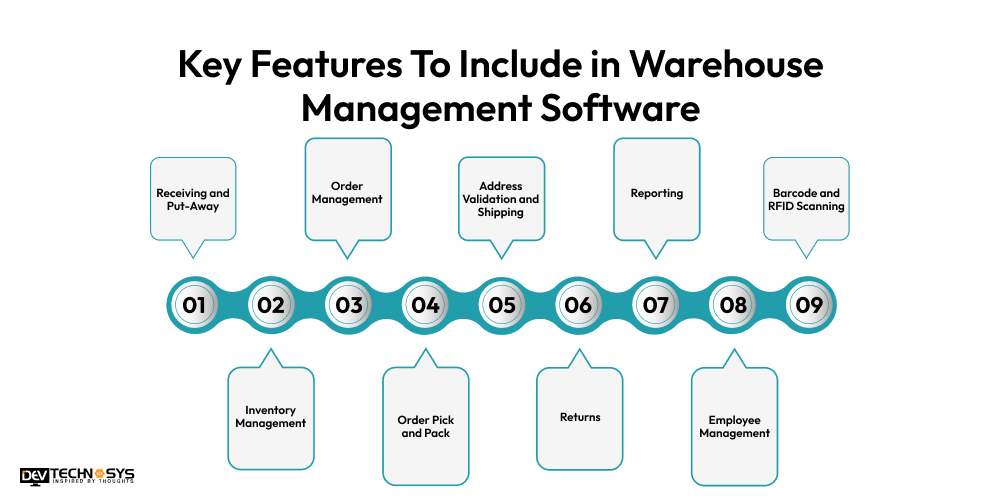
1. Receiving and Put-Away
With this feature, you can place purchase orders and “check-in” products, which assigns them to specific warehouse locations.
2. Inventory Management
You should look for a WMS that can keep track of kits, products, item inventory, pallet-case-single relationships, and more than one SKU per bin.
3. Order Management
A WMS should let you link your different sales channels and combine orders made in the system. So, when you develop logistic management software like Upper, you can integrate this feature in it.
4. Order Pick and Pack
A WMS’s primary function is to let workers pick products as part of a group order. Look for a WMS to divide orders among your workers and organize picking into waves, batches, and zones. It gives you information on location and quantity by scanning RFID or barcodes.
5. Address Validation and Shipping
Most WMS will connect to outside shipping services to give you multiple shipping choices, print labels, and keep track of your packages. Consider it if you need custom carrier options or shipments that go through more than one step.
6. Returns
Many WMSs include some return features, but for more advanced products, you might need to buy a separate module. This feature increases the cost of developing warehouse management software.
7. Reporting
You may have to pay extra if you want more detailed reports or to connect your WMS to your accounting or business intelligence software. All WMS will have some kind of reporting dashboard or export.
8. Employee Management
A WMS should let you assign people in the warehouse to specific tasks. Accounting and payroll software, on the other hand, is better at keeping track of time and payments.
9. Barcode and RFID Scanning
The warehouse software should be able to read barcodes and RFID tags to make work more accurate and faster. If you develop a barcode reader application or software, tracking items precisely throughout the warehouse reduces mistakes and raises inventory accuracy.
4 Tips to Optimize Cost To Build Warehouse Management Software
Now that you know the cost to build warehouse management software, it is vital to reduce the cost that cannot affect your budget. So, let’s have a look at the tips to optimize the cost to create warehouse management software.
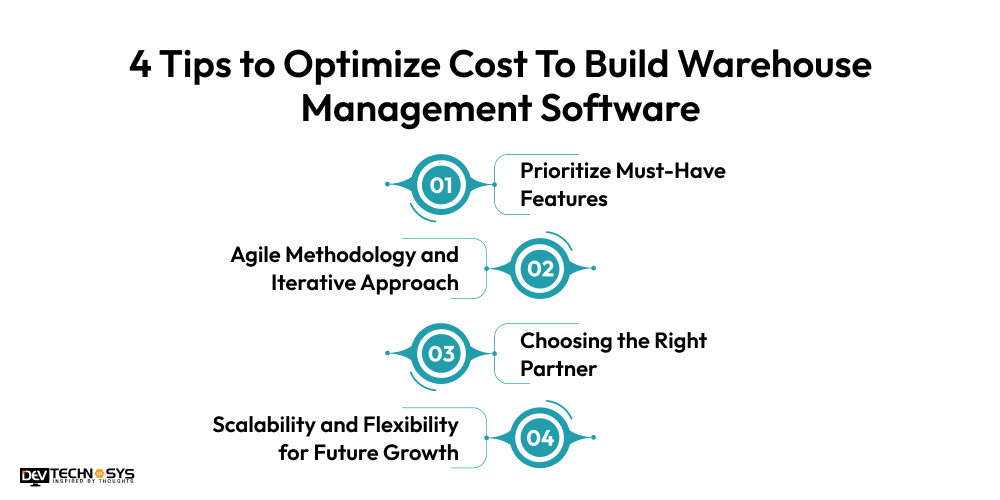
1. Prioritize Must-Have Features
Choose and rank the warehouse management system features that are essential for operations and business goals. This will ensure that development work and WMS software costs are completed on time.
Just ensure important features like managing inventory, analyzing and reporting on data, integrating, and optimizing order fulfillment.
2. Agile Methodology and Iterative Approach
The agile method focuses on delivering working software in shorter periods, which are called sprints. This strategy lets stakeholders and end users give feedback early on and regularly.
Besides, it makes it easier to prioritize features based on their value to the business. Using development resources in the best possible way ensures that the most important features. This reduces the cost of warehouse management system software.
3. Choosing the Right Partner
Choosing the right warehouse management software development company is very important for a good outcome. They use agile methods and good project management techniques and have a team of qualified and experienced professionals.
Knowing specific needs, workflows, and goals can help you make features and functions that meet those needs. This strategy gets rid of features and problems that are not needed. This lowers cost to build warehouse management software and gives the organization a WMS that exactly meets its needs.
4. Scalability and Flexibility for Future Growth
With a scalable WMS solution, the company cannot buy new, expensive systems as it grows. By breaking the software up into smaller, self-contained modules, it is easy to add or change specific features without affecting the whole system.
If you plan your WMS development with future growth and scalability in mind, you can easily reduce the costs of system improvements, redevelopments, and maintenance.
How To Monetize Warehouse Management Software?
Once your software is fully developed, Now what? How will you monetize your warehouse management software to earn huge revenue? Well, you need to utilize some revenue streams like below:
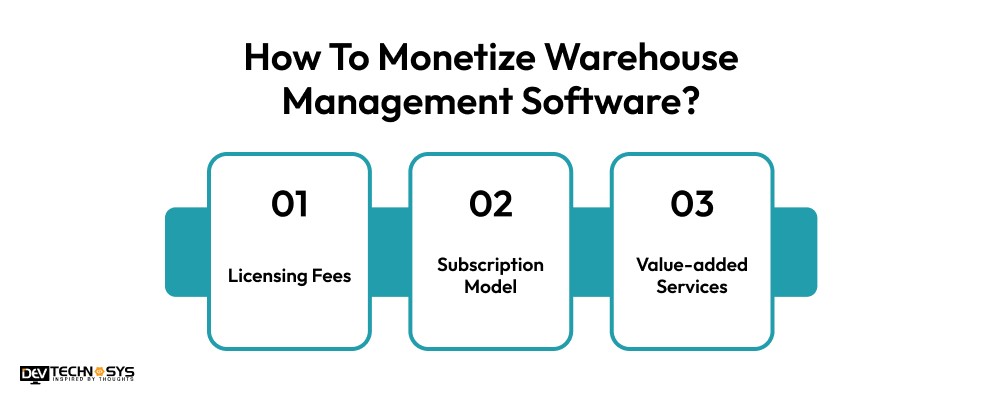
1. Licensing Fees
The usual way is to charge licensing fees upfront or regularly. This model is good for businesses that need a strong WMS and are ready to pay more for that solution’s features and support. You just hire dedicated developers to adapt to the needs and sizes of businesses. You can do this by providing different levels based on features, storage space, or the number of users.
2. Subscription Model
A model based on subscriptions gives you options and steady income. For access to the WMS, customers pay a fee either monthly or yearly. This model works great for businesses that want to pay as they go and need constant support and updates. To meet customers’ needs, you can offer different subscription plans with different features and prices.
3. Value-added Services
You can go beyond the basic WMS features and provide users with additional services. For example, customization, implementation, training, and consulting. You can earn extra money and make your customers happier. If they take time and effort, you can charge more for them.
Final Thoughts
The end result of creating the best warehouse management software that works is truly amazing. Before warehouse management software, it took a lot of work for businesses to keep track of where their inventory was and how much they had. This caused items to get lost or misplaced and wasted time looking for them.
With real-time visibility into inventory levels and locations, anyone can streamline their inventory management, use their warehouse layout best, and work more efficiently overall.
Our skilled software development services provider has decades of experience and can help you make the best warehouse management system.
FAQs
Q1. How Much Does It Cost To Develop Warehouse Management Software?
The cost to develop warehouse management system can range between $10000-$30000. However, this is not an accurate cost; it depends on your project requirements.
Q2. How Long Does It Take To Build Warehouse Management Software?
The time it takes to create warehouse management software is not the same. Factors like software complexity, tech stack, functionalities, etc., play a major role in cost fluctuation. Usually, it can take 2-8 months to develop warehouse management software.
Q3. How To Reduce the Warehouse Management Development Software Cost?
Here are the tips to reduce the cost of smart warehouse management development.
- Agile methodology and iterative approach
- Prioritize essential features
- Scalability and flexibility for future growth
- Choosing the right partner
Q4. What Are the Benefits To Make Warehouse Management Software?
Here are the benefits of warehouse inventory management software.
- Increased efficiency
- Better inventory management
- Improved customer service
- Reduced labor costs
- Enhanced traceability
Q5. How To Create Warehouse Management Software?
To make warehouse management software, just follow the below steps:
- Conduct market research
- Know your target audience
- Create a feature list
- Design user interface
- Develop the backend
- Test and release
- Maintenance and update
